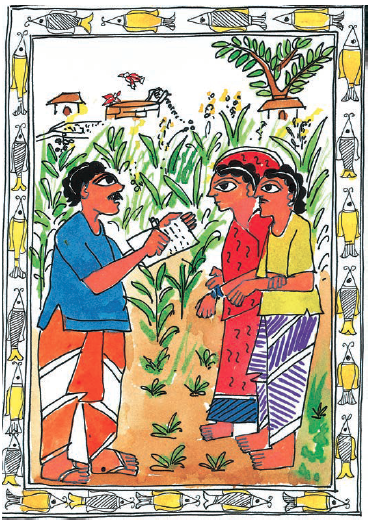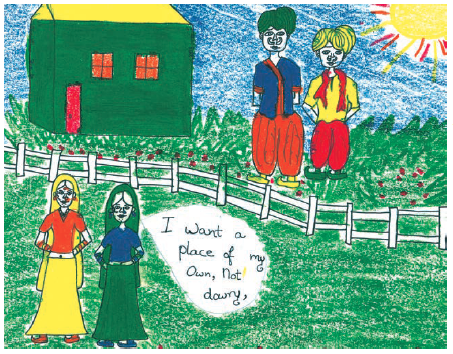Table of Contents
Chapter 6
Rural Administration
There are more than six lakh villages in India. Taking care of their needs for water, electricity, road connections, is not a small task. In addition to this, land records have to be maintained and conflicts too need to be dealt with. A large machinery is in place to deal with all this. In this chapter we will look at the work of two rural administrative officers in some detail.

A Quarrel in the Village
Mohan is a farmer. His family owns a small agricultural field, which they have been farming for many years. Next to his field is Raghu's land which is separated from his by a small boundary called a bund.
One morning Mohan noticed that Raghu had shifted the bund by a few feet. By doing so, he had managed to take over some of Mohan's land, and increased the size of his own field. Mohan was angry but also a little frightened. Raghu's family owned many fields and besides, his uncle was also the Sarpanch of the village. But even so, he plucked up courage and went to Raghu's house.
A heated argument followed. Raghu refused to accept that he had moved the bund. He called one of his helpers and they began shouting at Mohan and beating him up. The neighbours heard the commotion and rushed to the spot where Mohan was being beaten up. They took him away.
He was badly hurt on his head and hand. He was given first aid by one of his neighbours. His friend, who also ran the village post-office, suggested that they go to the local police station and file a report. Others were doubtful if this was a good idea because they felt they would waste a lot of money and nothing would come out of it. Some people said that Raghu's family would have already contacted the police station.
After much discussion it was decided that Mohan would go to the police station along with some of the neighbours who had seen the incident.
Area of the Police Station
On the way to the police station one of the neighbours asked, "Why don't we spend some more money and go to the main police station in the town?"
"It is not a question of money. We can register the case only in this police station because our village comes in its area of work," explained Mohan.
Every police station has an area that comes under its control. All persons in that area can report cases or inform the police about any theft, accident, injury, fight, etc. It is the responsibility of the police of that station to enquire, to investigate and take action on the cases within its area.
1. If there is a theft in your house which police station would you go to register your complaint?
2. What was the dispute between Mohan and Raghu?
3. Why was Mohan worried about picking a quarrel with Raghu?
4. Some people said Mohan should report the matter to the police and others said he should not. What were the arguments they gave?
The work at the Police Station
When they reached the police station Mohan went to the person in charge (Station House Officer or S.H.O.) and told him what had happened. He also said that he wanted to give the complaint in writing. The S.H.O rudely brushed him aside saying that he couldn't be bothered to waste his time writing down minor complaints and then investigating them. Mohan showed him his injuries but the S.H.O did not believe him.

Show the above situation in the police station through a skit. Then talk about how you felt playing Mohan's role or that of the S.H.O or the neighbours. Could the S.H.O have handled the situation differently?
Mohan was puzzled and did not know what to do. He was not sure why his complaint was not being recorded. He went and called his neighbours into the office. They argued strongly that Mohan had been beaten up in front of them and had they not rescued him he would have been injured very seriously. They insisted that the case be registered. Finally the officer agreed. He asked Mohan to write down his complaint and also told the people that he would send a constable the next day to investigate the incident.
Maintenance of Land Records
You saw that Mohan and Raghu were arguing heatedly whether the common boundary of their fields had been shifted. Isn't there a way by which they could have settled this dispute in a peaceful manner? Are there records that show who owns what land in the village? Let's find out how this is done.
Measuring land and keeping land records is the main work of the Patwari. The Patwari is known by different names in different states - in some villages such officers are called Lekhpal, in others Kanungo or Karamchari or Village Officer etc. We will refer to this officer as Patwari. Each Patwari is responsible for a group of villages. The Patwari maintains and updates the records of the village.
 The map and the corresponding details from the register on the next page are a small part of the records kept by the Patwari.
The map and the corresponding details from the register on the next page are a small part of the records kept by the Patwari.
The Patwari usually has ways of measuring agricultural fields. In some places a long chain is used. In the above instance the Patwari would have measured both Mohan's and Raghu's fields and compared them with the measurements on the map. If they did not match then it would be clear that the boundary of the fields has been changed.
Find out the term used for the Patwari in your state.
If you live in a rural area find out:
How many villages does the Patwari of your area maintain land records of?
How do people in the village contact him/her?
The Patwari is also responsible for organising the collection of land revenue from the farmers and providing information to the government about the crops grown in this area. This is done from the records that are kept, and this is why it's important for the Patwari to regularly update these. Farmers may change the crops grown on their fields or someone may dig a well somewhere, and keeping track of all this is the work of the revenue department of the government. Senior people in this department supervise the Patwari's work.
The Khasra record of the Patwari gives you information regarding the map given below. It identifies which plot of land is owned by whom. Look at both the records and the map and answer the questions given below regarding Mohan and Raghu's land.


1. Who owns the land south of Mohan's field?
2. Mark the common boundary between Mohan's and Raghu's lands.
3. Who can use field no 3?
4. What information can one get for field no 2 and field no 3?
All states in India are divided into districts. For managing matters relating to land these districts are further sub-divided. These subdivisions of a district are known by different names such as tehsil, taluka, etc. At the head is the District Collector and under her are the revenue officers, also known as tehsildars. They have to hear disputes. They also supervise the work of the Patwaris and ensure that records are properly kept and land revenue is collected. They make sure that the farmers can easily obtain a copy of their record, students can obtain their caste certificates etc. The Tehsildar's office is where land disputes are also heard.

Farmers often require a copy of their land's record together with a map, as shown in the previous illustration. They have a right to this information. They may have to pay a small fee for this.
However, this information is not easily made available and farmers sometimes have to face many problems to get it. In some states, records are now being computerised and also kept at the Panchayat office so that they are more easily available and regularly updated.
When do you think farmers may require a copy of this record? Study the following situations and identify the cases in which these records would be necessary and why.
* A farmer wants to buy a plot of land from another.
* A farmer wants to sell her produce to another.
* A farmer wants a loan from the bank to dig a well in her land.
* A farmer wants to purchase fertilizers for his field.
* A farmer wants to divide his property among his children.
A daughter's wish
Father inherited our house
from his father
And everyone says he'll
leave it to brother
But what about me and my
mother?
To expect a share in my
father's home,
Is not very womanly, I am
told.
But I really want a place of
my own,
Not dowry of silk and gold.
(Source: Reflections on MY FAMILY,
Anjali Monteiro,TISS)
A New Law
(Hindu Succession Amendment Act, 2005)
Often when we think of farmers who own land, we think of men. Women are seen as people who work on the fields, but not as people who own agricultural land. Till recently in some states Hindu women did not get a share in the family's agricultural land. After the death of the father his property was divided equally only among his sons.
Recently, the law was changed. In the new law sons, daughters and their mothers can get an equal share in the land. The same law will apply to all states and union territories of the country.
This law will benefit a large number of women. For example Sudha is the eldest daughter of an agricultural family. She is married and lives in a neighbouring village. After her father's death Sudha often comes to help her mother with the farming work.
Her mother has asked the Patwari to transfer the land and enter her name along with the names of all the children in his record.
Sudha's mother confidently organises the farming with the help of the younger brother and sister. Similarly Sudha also lives with the assurance that if she ever has a problem she can always depend upon her share of the land.
Other Public Services - A survey
This chapter has looked at some of the administrative work of the government, especially for rural areas. The first example related to maintaining law and order and the second to maintaining land records. In the first case we examined the role of the police and in the second that of the Patwari. This work is supervised by other people in the department, such as the Tehsildar or the Superintendent of Police. We have also seen how people use these services, and some of the problems that they face. These services have to be used and made to function according to the laws that have been framed for them. You have probably seen many other public services and facilities provided by various departments of the government.
Do the following exercise for your village/by visiting a nearby village or looking at your own area.
List the public services in the village/area such as: the milk society, the fair price shop, the bank, the police station, the agricultural society for seeds and fertiliser, the post office or sub post office, the anganwadi, crèche, government school/s, health centre or government hospital etc. Collect information on three public services and discuss with your teacher how improvements can be made in their functioning. One example has been worked out.

QUESTIONS
1. What is the work of the police?
2. List two things that the work of a Patwari includes.
3. What is the work of a tehsildar?
4. What issue is the poem trying to raise? Do you think this is an important issue? Why?
5. In what ways are the work of the Panchayat, that you read about in the previous chapter, and the work of the Patwari related to each other?
6. Visit a police station and find out the work that the police have to do to prevent crime and maintain law and order in their area especially during festivals, public meetings etc.
7. Who is in charge of all the police stations in a district? Find out.
8. How do women benefit under the new law?
9. In your neighbourhood are there women who own property? How did they acquire it?
